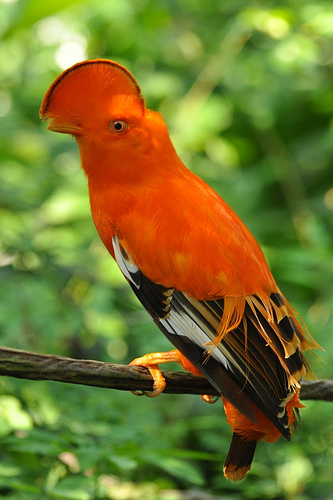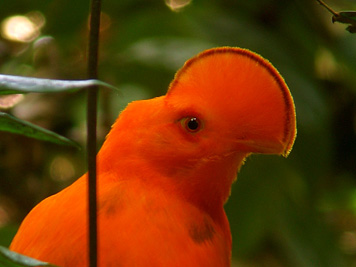
Rupicola rupicola
TAXONOMY
Rupicola rupicola Linnaeus, 1766.
OTHER COMMON NAMES
French: Coq-de-roche orange; German: Cayenne Klippenvogel;
Spanish: Gallito de Rocas Guayanйs.
PHYSICAL CHARACTERISTICS
While the female is a drab brown color, the male’s plumage is a
bright orange; the head is decorated with a helmet-like erect
crest. The bright coloration is derived from zeaxanthin, the
same pigment found in corn (Zea mays), which it is named for.
This pigmentation often fades rapidly in taxidermied specimens.
DISTRIBUTION
This species is found in northern Amazonia and the Guianan
shield, from southeastern Colombia through southern
Venezuela and northern Brazil, eastward through French
Guiana. It is found at lower elevations, typically not exceeding
4,900 ft (1,500 m).
HABITAT
Lowland forest.
BEHAVIOR
When flying, a loud “hissing” sound is produced from the
modified remige of the wing tip. A spectacular array of vocalizations
are produced, including different “popping” noised
produced by snapping the bill. In the courtship season, males
gather on rocks amid the foam of river rapids to display their
colors in most unusual dances. Robert Schomburgk
(1804–1865), the well-known South American traveler, described
these dances as follows: “A whole troop of these wonderful
birds was holding their dance on the smooth, flat upper
surface of a tremendous rock. About twenty admiring observers,
both males and females, sat on the bushes nearby while
a male moved about over the top of the rock in every direction
with some rather unusual movements. It would spread its
wings, toss its head in every direction, scratch the rock with its
primaries, and hop upwards at varying speeds, always from the
same point; again it would fan out and erect its tail and once
more walk about coquettishly with proud steps. When it
seemed to be tired, it uttered a different phrase from the usual
call and, flying to the nearest twig, it left its place on the rock
to another male. After awhile, this second bird, having first
demonstrated its grace and readiness to dance, gave way to a
third male.” Up to 50 males have been observed at a lek.
FEEDING ECOLOGY AND DIET
Like most cotingas, the cocks-of-the-rock consume fruits primarily,
but will consume more animal matter as fruits become scarce.
REPRODUCTIVE BIOLOGY
Polygynous. Nests are typically located near the male lekking
grounds, and sometimes several females build nests close to
each other. The cup shaped nests are typically plastered to a
damp rock face within crevices of cliffs or ravines, often over a
stream. The nest may weigh nearly 2.2 lb (1 kg), and is made
of clay mixed with vegetable fibers and is often covered with
lichens. The female lays two spotted brownish eggs, and the
incubation period is 27–28 days. When the chicks hatch the
males can be distinguished from females as their feet and bills
are yellow and black, respectively.
CONSERVATION STATUS
While neither species is listed as Threatened or Endangered,
quite a few individuals were taken during the 1900s for the live
bird trade. However, trade is much more restricted today.
SIGNIFICANCE TO HUMANS
Natives may eat cock-of-the-rock flesh. Because of their bright
plumage, cocks-of-the-rock are hunted by men of numerous
Indian tribes. The Emperor of Brazil had a mantle made of
cock-of-the-rock feathers.
Other popular Animals
Photo Gallery of - Guianan cock-of-the-rock




 Animalia Life
Animalia Life